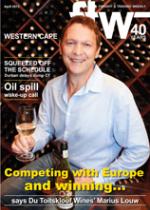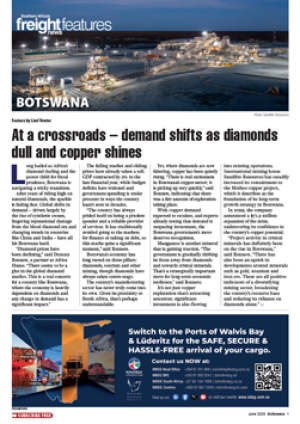With South Africa’s
traditional markets still
reeling from the global
economic meltdown, a viable and
relevant product is essential for
successful exporting.
It was with this in mind that
Marius Louw, managing director
of Du Toitskloof Wines near
Rawsonville in the Western Cape,
set about transforming his product
for the international market,
ensuring an export market for years
to come.
“I think we are in the fortunate
position that we are not necessarily
dependent on exports as the bulk
of our product is sold locally, either
in bulk or in bottle,” he said. “But
growing our export market is very
much a part of our future growth
strategy and it was imperative
that we looked at innovative ways
of entering the well-established
European market that at the same
time is facing a tough economic
time.”
The company entered the export
market just over five years ago
and figures are showing a steady
increase. Currently 20% of the wine
produced annually is exported, and
the intention is to continue growing
exports. But competing from South
Africa with the likes of established
wine-producing regions like
France, Spain and Portugal is not
an easy task.
“Our wine is just as good as
the product being produced in
mainland Europe – if not better –
but how do we compete when it
comes to cost? Not only are we far
from our export market, we also
have some of the highest logistics
cost in the world,” said Louw. “It is
just not possible to sell our product
at the same price, so we set about
changing our export profile to
allow us to be more competitive in
the European market.”
Producing some 3 million litres
of wine every year – of which
more than 2 million litres go to the
local market – Louw and his team
decided to look at bulk exports
versus containers moving bottles
of wine.
“We use a combination of both,
with some of our product still
being bottled locally before being
exported in containers, but most of
our export wine is now shipped out
in bulk. Not only does that allow us
to move more product at a time, it
is also more cost-effective and the
wine is fresher when it reaches the
consumer.”
With bottling plants in the UK
and Germany, Louw says they are
now able to actively compete in the
market by bringing product to the
consumer that does not cost an arm
and a leg.
At the same time the
development of cheaper packaging
has been part of the innovative
process.
“The tetra pack is a lightweight
disposable packaging for our wine
that is far cheaper for the consumer.
At the same time it is a “greener”
option and it allows us to compete
in a different league in a remote
market.”
And the rate of sales of the
new cost-efficient packaging has
exceeded expectations.
“By using a cheaper packaging
we are at the same time making
wine more accessible to the general
public. No longer do you have to
be a connoisseur to enjoy a good
glass of wine. Through this process
we have not only managed to be
a viable exporter to Europe, we
have also introduced an affordable
wine that is easy on the palate and
that can be enjoyed by the average
person.”
For him successful exporting lies
in knowing one’s product.
“As exporters there are things
we have some control over and
then some things we have no
control over – like the volatility
of the exchange rate. Ultimately,
if I want to be successful, I need
to shape my business model to
accommodate those factors that I
can’t control.”
For that reason the company has
embraced a culture of shipping
“just in time”. “Yes, it is risky
should there be a strike at the port,
but on the other side of the coin I
am sending fresher produce more
frequently and I am not spending
huge amounts of money on
warehousing and other costs.”
For Louw it comes down to
knowing what the risks are and then
taking calculated decisions that suit
one’s individual business model.
CAPTION
Marius Louw … ‘By using a cheaper packaging we are making wine more accessible
to the general public.’

